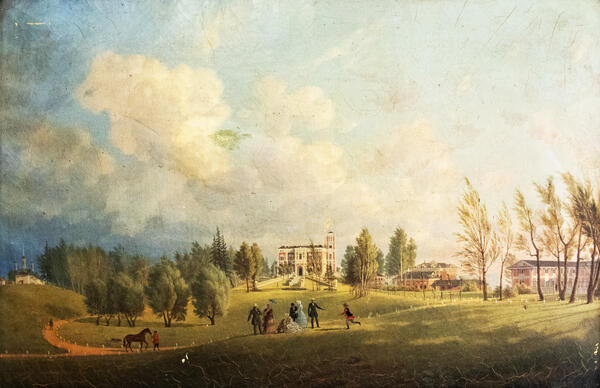Painting ‘Bykovo. The Vorontsov-Dashkov Manor’ by DominIk Gagen (1853, oil on canvas) was brought to the RAmenskoye Museum in 1930 from the Bronnitsy Museum, where it came after nationalization from one of the manors that were once located in the Bronnitsy district.
Dominik Ernestovich Gagen (1810-1876) served as the province secretary. In 1837, the Academy of Arts granted him the title of a drawing teacher in secondary schools, and in 1859, the title of artist for his watercolor painting ‘Crowd Scene in Little Russia.’
Painting ‘Bykovo. The Vorontsov-Dashkov Manor’ is of great value for the study of the estate, as it was made shortly after the manor was rebuilt. Gagen depicted the manor in the open country, therefore the park in front of it was made much later. When creating this canvas, the artist strove to show the manor life with the utmost completeness, using staffage to achieve his goal.
Staffage is a term of landscape painting, meaning small figures of people and animals that bring a landscape painting to life. It was popular in the 16th-17th centuries, when landscape artists added everyday, mythological and religious scenes to their works.
The painting shows a panoramic view of the estate. In the center, we can see the main manor standing on a man-made hill. Figures of strolling guests and owners of the manor, to whom a servant is showing a horse, bring the painting to life.
The Bykovo Manor has a long history; it has had several different owners from well-known Russian families. According to sources, the first mention of Bykovo was found in the testament of Dmitry Donskoy, the last will he made before the Battle of Kulikovo. According to other sources, the village was first mentioned in the times of Ivan the Terrible.
The first owner of Bykovo from the Vorontsov family was Governor Illarion: he received the village as a gift from Peter I for his merit for the Motherland. The village passed to the heirs of the Vorontsov family until mid-18th century.
In August 1807, by the decree of Emperor Alexander I, Count Ivan Vorontsov, the grand-nephew of the lady-in-waiting Princess Dashkova, was allowed to take a double-barrelled surname. Since the main branch of the Dashkov family had discontinued, Ivan Illarionovich inhereted the surname and became Count Vorontsov-Dashkov.
In the 1830s, Count Vorontsov-Dashkov undertook a reconstruction of his dilapidated Bykovo estate near Moscow. On the site of the old house designed by Bazhenov, a popular big-city architect Bernard de Simon built a two-story manor resembling a Tudor-era English castle. All four faces of the palace are designed in a different style; the painting shows only one of them.
Dominik Ernestovich Gagen (1810-1876) served as the province secretary. In 1837, the Academy of Arts granted him the title of a drawing teacher in secondary schools, and in 1859, the title of artist for his watercolor painting ‘Crowd Scene in Little Russia.’
Painting ‘Bykovo. The Vorontsov-Dashkov Manor’ is of great value for the study of the estate, as it was made shortly after the manor was rebuilt. Gagen depicted the manor in the open country, therefore the park in front of it was made much later. When creating this canvas, the artist strove to show the manor life with the utmost completeness, using staffage to achieve his goal.
Staffage is a term of landscape painting, meaning small figures of people and animals that bring a landscape painting to life. It was popular in the 16th-17th centuries, when landscape artists added everyday, mythological and religious scenes to their works.
The painting shows a panoramic view of the estate. In the center, we can see the main manor standing on a man-made hill. Figures of strolling guests and owners of the manor, to whom a servant is showing a horse, bring the painting to life.
The Bykovo Manor has a long history; it has had several different owners from well-known Russian families. According to sources, the first mention of Bykovo was found in the testament of Dmitry Donskoy, the last will he made before the Battle of Kulikovo. According to other sources, the village was first mentioned in the times of Ivan the Terrible.
The first owner of Bykovo from the Vorontsov family was Governor Illarion: he received the village as a gift from Peter I for his merit for the Motherland. The village passed to the heirs of the Vorontsov family until mid-18th century.
In August 1807, by the decree of Emperor Alexander I, Count Ivan Vorontsov, the grand-nephew of the lady-in-waiting Princess Dashkova, was allowed to take a double-barrelled surname. Since the main branch of the Dashkov family had discontinued, Ivan Illarionovich inhereted the surname and became Count Vorontsov-Dashkov.
In the 1830s, Count Vorontsov-Dashkov undertook a reconstruction of his dilapidated Bykovo estate near Moscow. On the site of the old house designed by Bazhenov, a popular big-city architect Bernard de Simon built a two-story manor resembling a Tudor-era English castle. All four faces of the palace are designed in a different style; the painting shows only one of them.


